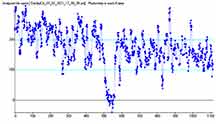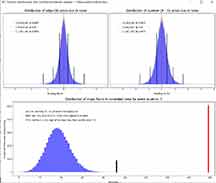



Pre- Event...
The path for this event crosses the North Bay in low tidal lands. It's therefore at the mercy of fog and wind, if we have a strong marine inflow. The discovery in late May '21 this is a binary asteroid was by Dave Gault/Peter Nosworthy, and confirmed by myself and Kirk's occultation June 9, 2021, make this a high priority event and there are 15 claimed chords.
I'm considering sites at the location on the map below, but more likely farther west or east, depending on weather and wind forecasts as they clarify. If farther west continues to look more favorable as far as clouds, it would likely be the Lynch Canyon Recreation parking lot off I-80 for Kirk, and I'd use my car for wind protection from a few miles further north.
 |
 |
 |
 |
 |
 |
My Team (me, Kirk, Chris K) all got good data of the main body occultation, but no confirmed secondary occultations. If the satellite caused an event at any station, it would most likely be mine at the supposed southern edge of the satellite, since Chris and Kirk were both south of me and close enough and data good enough that one of them would have seen it. There was (so far as we know) no one who got the event north of me. But my data's not great - high winds were the trouble.
Here's the YouTube link to the video footage of the set up and commentary (will go live when it's ready). The event was so difficult to see on my video tape that there's no point in uploading to YouTube
I observed at the end of a frontage dead end road about 7km NE of Kirk Bender. I had no tree protection from strong winds, and needed to set up my RAV4 in such a way as to best block the wind. Even that wasn't enough, and I ended up tying my blue table (the roll up camp table) to the roof of my RAV4 and lashing two of the legs to the bike carrier rear bar. That held during the occultation, but shortly afterwards, it worked itself loose, flew off the roof, over the telescope (missing it) and knocked me over. Poor seeing, bright sky were a problem. I used 8x integration on the Watech 910hx.
I tried 5 different PyMovie and PyOTE reductions, fiddling with parameters, but could not improve the S/N beyond what you see. The problem is that the wind shake created PyMovie inability to track the target and tracking star and the results mimiced occultations, so the statistical significant suffered. If there had not been wind, it would be much higher. The easy way to tell that the dropouts were due to wind shake is that the shake blur is obvious on the .avi file as you watch. But during the actual occultation and for most of the prior 40 seconds, there was no real wind shake. The event happened with not much wind shake until about 5 seconds AFTER the main body event, when strong wind gusts started coming through off and on. Also, I had my headlamp into the telescope blinding the camera at 5:57:06 and so I can't keep any data before that. The unfortunately short stretch of clean data also hurt the PyOTE assessment of statistical significance. If PyOTE had a way of letting the observer specify stretches of light curve which could be legitimately ignored due to passing car lights or wind shake, so that the entire valid parts of the light curve could be used in the significance calculation, that would be a welcome advance.
|
my site - at what I judged an optimum cross-track distance from Kirk. But no wind protection except what I could muster with my car and anything from within it. |
Zoomed in. Occultation labelled, wind trouble after that |
PyOTE determined the timings of D and R. |
The 99.995% criteria is the black bar. The significance of my event (red) is underestimated because I truncated the sample of the light curve which was not affected by wind. It would be great if PyOTE allowed the user to specify periods in the light curve to disregard in doing its significance testing. |
Zoomed on on PyOTE light curve. I did not use a comparison star, it didn't help when I tried, it only increased the noise in quadrature. 8X setting means each point here is 4 original frames on the video. |
my PyOTE Log file and my PyMovie photometry file for the best of my attempts: #2. As always, the IOTA reports are stored in another folder and not uploaded to the website to save website space. The reports for all 3 observers here were sent off on July 2 to IOTA.
I used Google Earth to find a good protected site for Kirk Bender, between two giant oak trees that absorbed the wind which came out of the WSW, while the occultation was in the SE. He had no trouble and good S/N at 4x because of this.
|
Kirk's site, a locked gate off a frontage road, leading to an abandoned plot. |
Using iPhone app "SkySafari Pro" to determine the altitude of the event with the earl Earth horizon, and verify what I'd determined off of Google Earth as to the exact azimuth and where to set up to get the event through the trees. |
"It'll happen right over.... THERE, Kirk". Yup, just as I figured from Google Earth. |
Raw light curve in PyMovie |
High significance of event. Being able to work at 4x setting doubled his number of data points and adds significance. Also having no dropouts due to wind shake helped his False Positive number enormously. |
|
Error histogram for the time of the D |
Error histogram for interval timing of occultation |
Zoomed in on event |
Entire light curve in PyOTE |
Pyote Screen capture |
|
Screen capture of Kirk's reductions in PyMovie |
Kirk's site - nicely placed between two huge oak trees with plenty of leaves to absorb wind energy, and a clear low path down to the target. |
Chris observed from a marina just north of Oakly, where he was doing some marine biology studies, on the south side of the projected path profile, further south than Kirk but still decently above the southern limit. He used a 10" Newtonian and Watec 910hx and got good data, but trouble with LiMovie reading the video. Strangely, he recorded a 1.78s event; longer than either Kirk or my events by a little. The main asteroid path is well-determined, as predicted by Dunham and confirmed by both the Australia and my and Kirk's June 9 occultation. So having an occultation longer than the predicted duration by a bit, so close to the southern limit is at least suggestive that perhaps the satellite and moon were overlapping.
 |
 |
 |
CLK's LiMovie photometry and the PyOTE.csv and PyOTE log file